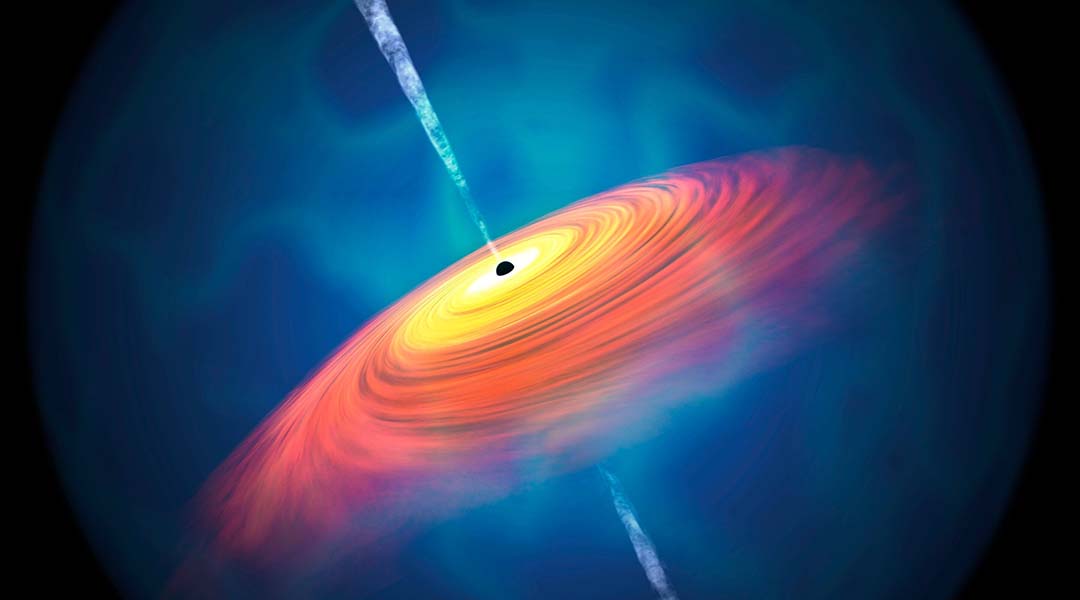Astronomical observations made in the past few decades have revealed that all galaxies harbor black holes, which feed on the stars, planets, and interstellar gas. They have an insatiable appetite, consuming matter over billions of years, allowing them to grow to masses that are millions or even billions of times the mass of our own Sun. This endless growth and their colossal sizes have aptly earned them the name supermassive black holes.
The masses of these gargantuan celestial bodies account for about 0.1% of the total mass of any galaxy in which they reside, prompting researchers to believe that their growth and the process of galaxy formation are closely related.
To test this hypothesis and study the interaction between black holes and their galaxies, it is necessary to observe them at different stages of their evolution, including at their earliest moments of development.
Although they are billions of years old, this is still possible thanks to the finite speed of light. When we observe radiation from a distant galaxy, we are essentially peering back in time, as it takes a considerable amount of time for that light to reach Earth. This unique feature allows us to study galaxies when they were much younger and in their formative stages.
However, with the observation of galaxies, the farther away it is from us, the harder it is to see. This means studying the formation of galaxies in the early Universe requires very powerful telescopes.
Peering further back in time
Until recently, scientists were only able to peer into the evolutionary history of supermassive black holes no later than one billion years after the Big Bang, but in a new study published in The Astrophysical Journal, an international team of astrophysicists was able to breach this barrier.
“We used the Subaru Telescope at the top of Maunakea, Hawaii, for the present study,” Yoshiki Matsuoka, a professor at Ehime University in Japan and one of the authors of the study, said in a press release. “One of the biggest advantages of Subaru is its widefield observing capability, which is particularly suited for our purpose.
“Since [supermassive black holes] do not emit light, we looked for […] ‘quasars’ — [supermassive black holes] with shining outskirts where the infalling material releases gravitational energy, [that are observed as electromagnetic waves].”
With the Subaru Telescope, the researchers say they discovered 162 quasars, 22 of which were less than 800 million years old. By combining this data with information about 13 other young quasars discovered in earlier studies, they were able to probe important properties of the gigantic black holes back in the early Universe.
“The large number of quasars we discovered has allowed us to determine the most fundamental measure called the ‘luminosity function,’ which describes the space density of quasars as a function of radiation energy,” explained Matsuoka. “We found that quasars were forming very rapidly in the early Universe, while the overall shape of the luminosity function (except for the amplitude) remained unchanged over time.”
A deeper understanding
This new insight into the quasars’ luminosity function places strong restrictions on theoretical models describing the formation of supermassive black holes. Although a complete theory of this process does not yet exist, the data obtained in the current study will help provide invaluable knowledge for its future development.
This study is also a step toward improving our understanding of the influence of quasar radiation on the process of reionization, a pivotal cosmic event that took place approximately 150 million to 1 billion years after the Big Bang. This period was marked by the transition from a universe dominated by neutral atoms to one dominated by ionized plasma, created by the increasing radiation from the first massive stars.
The number of ionized atoms in turn affected the cosmic microwave background, a pervasive afterglow left over from the earliest stages of the evolution of the Universe. By studying the properties of this radiation now, we can calculate the number of ions reionization rate and compare it with experimental data.
Many scientists believed that quasars were the main source of reionizing radiation, but the results of the current study showed that the number of photons emitted by quasars was way too small.
“By integrating the above luminosity function, we found that quasars emit 1028 photons per second in a unit volume of one light-year on a side in the early Universe,” Matsuoka said. “This is less than 1% of the photons needed to maintain the ionized state of the intergalactic space at that time, and thus indicates that quasars made only a minor contribution to cosmic reionization.”
“Other energy sources are critically needed, which, according to other recent observations, may be the integrated radiation from massive hot stars in forming galaxies,” he added.
The researchers believe that modern and future telescopes, including the James Webb Space Telescope, Euclid, Rubin Observatory and Roman Telescope, will provide even deeper insights into the history of the Universe. Both phenomena, the interactions of black holes with their galactic surroundings and the sources of reionizing radiation, are deeply rooted in the physics of the elementary particles and their interactions.
Thus, investigating them has the potential to advance our knowledge of the structure of the Universe at the most fundamental level.
Reference: Yoshiki Matsuoka et al., Quasar Luminosity Function at z = 7, The Astrophysical Journal Letters (2023). DOI: 10.3847/2041-8213/acd69f
Feature image: A supermassive black hole absorbs surrounding material, which forms a spiral disk-like shape as it flows in. Credit: Yoshiki Matsuoka, Ehime University

















